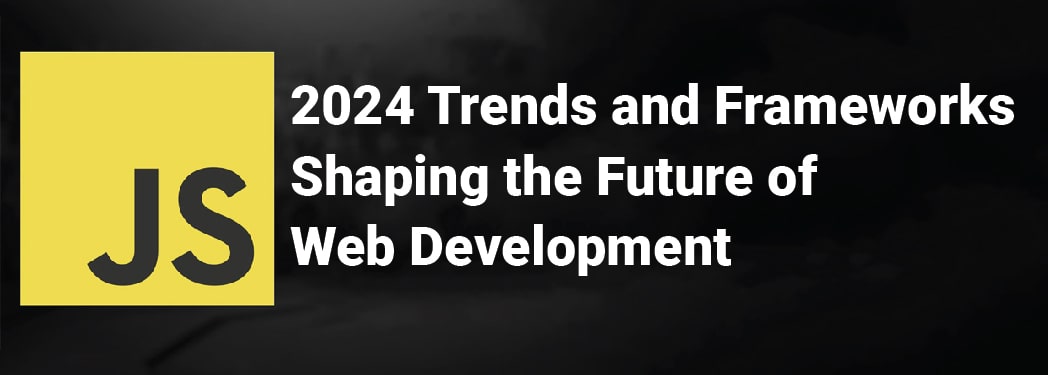JavaScript in 2024: Trends and Frameworks Shaping the Future of Web Development

As we move deeper, JavaScript Trends of 2024 continues to dominate the web development landscape, evolving with new trends, frameworks, and libraries that shape how we create interactive and dynamic web applications. This year, we’re witnessing significant shifts that not only refine how developers work but also enhance the user experience across web platforms. Let’s dive into the latest trends and frameworks in JavaScript that are marking their influence on the future of web development.
The Rise of Modern Frameworks and Libraries
React: Leading the Frontend
React, developed by Facebook, remains at the forefront, evolving with hooks and concurrent mode features that make it more robust and efficient for building user interfaces. Its component-based architecture and vast ecosystem continue to attract developers, making it a preferred choice for both new projects and legacy application upgrades.
Vue.js: The Progressive Framework
Vue.js has carved its niche as a progressive JavaScript framework, known for its simplicity and flexibility. It’s increasingly being adopted for both small projects and large-scale applications due to its gentle learning curve and its ability to enhance HTML with minimal overhead. Vue 3, with its Composition API, provides a more efficient way of managing component logic, making it a compelling choice for modern web development.
Angular: The Full-Featured Framework
Angular, maintained by Google, is favored for complex enterprise-level applications thanks to its comprehensive suite of tools and features, including a powerful CLI, strong typing with TypeScript, and a well-defined structure for large-scale project management. Its commitment to regular updates keeps it relevant and powerful for developers seeking a robust framework for their next big project.
Emerging Trends in JavaScript Development
Serverless and JAMstack Architectures
The shift towards serverless architectures and JAMstack (JavaScript, APIs, and Markup) is revolutionizing how web applications are built and deployed. These paradigms leverage the power of cloud functions, static site generators, and APIs to deliver faster, more scalable, and secure applications. Frameworks like Next.js and Nuxt.js are at the forefront, simplifying the development of serverless and JAMstack applications with JavaScript.
TypeScript: Enhancing JavaScript’s Robustness
TypeScript continues to gain traction among JavaScript developers for its ability to add strong typing to the language. This not only helps in catching errors early but also enhances code quality and maintainability. More frameworks and libraries are offering first-class TypeScript support, making it a key player in the future of JavaScript development.
The Expansion of Web Components
Web Components are a set of web platform APIs that allow developers to create new custom, reusable, encapsulated HTML tags for web pages and web apps. Libraries like LitElement are making it easier to build fast, lightweight components that are compatible across different frameworks, furthering the component-based architecture approach in web development.
Reactivity and State Management
The concepts of reactivity and state management continue to evolve, with libraries like Redux, MobX, and the newer Recoil and Zustand gaining popularity. These tools offer developers efficient ways to manage application state, ensuring that UIs remain responsive and performant, even as applications grow in complexity.
Conclusion
JavaScript’s landscape in 2024 is vibrant and constantly evolving, with frameworks and libraries that cater to every need and preference. As developers, staying abreast of these trends and understanding the strengths and use cases of each framework will be key to selecting the right tools for our projects. Whether it’s building fast, reactive user interfaces, managing application state, or leveraging new web platform features, JavaScript and its ecosystem continue to offer powerful solutions that shape the future of web development.
As we move deeper, JavaScript Trends of 2024 continues to dominate the web development landscape, evolving with new trends, frameworks, and libraries that shape how we create interactive and dynamic web applications. This year, we’re witnessing significant shifts that not only refine how developers work but also enhance the user experience across web platforms. Let’s dive into the latest trends and frameworks in JavaScript that are marking their influence on the future of web development.
The Rise of Modern Frameworks and Libraries
React: Leading the Frontend
React, developed by Facebook, remains at the forefront, evolving with hooks and concurrent mode features that make it more robust and efficient for building user interfaces. Its component-based architecture and vast ecosystem continue to attract developers, making it a preferred choice for both new projects and legacy application upgrades.
Vue.js: The Progressive Framework
Vue.js has carved its niche as a progressive JavaScript framework, known for its simplicity and flexibility. It’s increasingly being adopted for both small projects and large-scale applications due to its gentle learning curve and its ability to enhance HTML with minimal overhead. Vue 3, with its Composition API, provides a more efficient way of managing component logic, making it a compelling choice for modern web development.
Angular: The Full-Featured Framework
Angular, maintained by Google, is favored for complex enterprise-level applications thanks to its comprehensive suite of tools and features, including a powerful CLI, strong typing with TypeScript, and a well-defined structure for large-scale project management. Its commitment to regular updates keeps it relevant and powerful for developers seeking a robust framework for their next big project.
Emerging Trends in JavaScript Development
Serverless and JAMstack Architectures
The shift towards serverless architectures and JAMstack (JavaScript, APIs, and Markup) is revolutionizing how web applications are built and deployed. These paradigms leverage the power of cloud functions, static site generators, and APIs to deliver faster, more scalable, and secure applications. Frameworks like Next.js and Nuxt.js are at the forefront, simplifying the development of serverless and JAMstack applications with JavaScript.
TypeScript: Enhancing JavaScript’s Robustness
TypeScript continues to gain traction among JavaScript developers for its ability to add strong typing to the language. This not only helps in catching errors early but also enhances code quality and maintainability. More frameworks and libraries are offering first-class TypeScript support, making it a key player in the future of JavaScript development.
The Expansion of Web Components
Web Components are a set of web platform APIs that allow developers to create new custom, reusable, encapsulated HTML tags for web pages and web apps. Libraries like LitElement are making it easier to build fast, lightweight components that are compatible across different frameworks, furthering the component-based architecture approach in web development.
Reactivity and State Management
The concepts of reactivity and state management continue to evolve, with libraries like Redux, MobX, and the newer Recoil and Zustand gaining popularity. These tools offer developers efficient ways to manage application state, ensuring that UIs remain responsive and performant, even as applications grow in complexity.
Conclusion
JavaScript’s landscape in 2024 is vibrant and constantly evolving, with frameworks and libraries that cater to every need and preference. As developers, staying abreast of these trends and understanding the strengths and use cases of each framework will be key to selecting the right tools for our projects. Whether it’s building fast, reactive user interfaces, managing application state, or leveraging new web platform features, JavaScript and its ecosystem continue to offer powerful solutions that shape the future of web development.




























